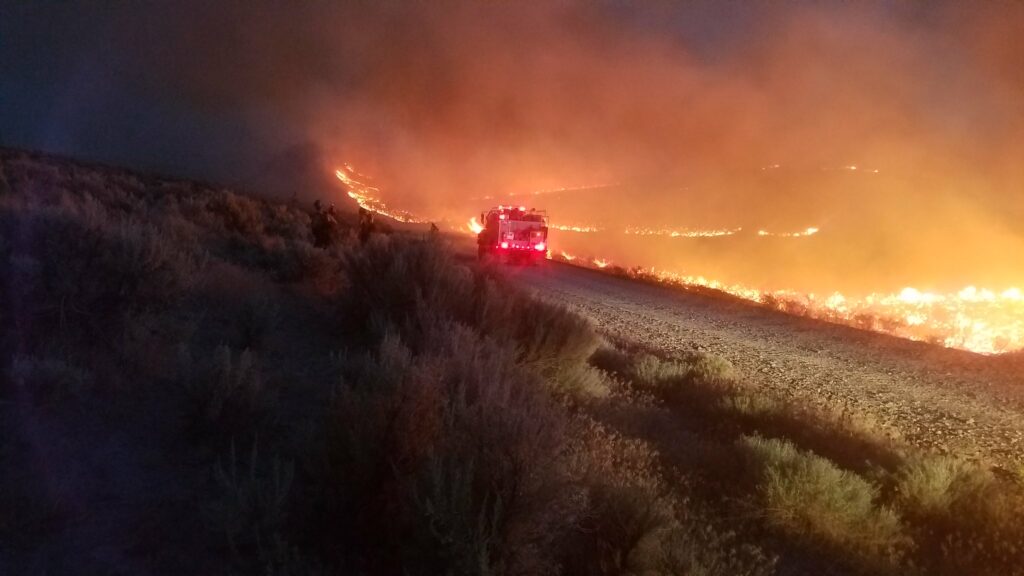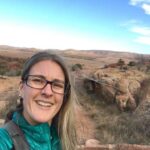Western wildfire expert thinks ‘we need to scrap the whole process and make a new one’

Good morning, and welcome to the Indy Environment newsletter. I'm Amy Alonzo, the environment reporter for The Indy.
With busy lives, it’s easy to slip into the mentality of “out of sight, out of mind.” But for land managers, scientists and fire officials, wildfires are constantly on the mind, whether it’s predicting and managing blazes or studying the impacts of fires and how to mitigate them.
At IndyFest, an annual conference hosted in Las Vegas by The Nevada Independent, two of Nevada’s leading wildfire experts — Tim Brown, director of the Western Regional Climate Center at the Desert Research Institute, and Christina Restaino, director of the Living With Fire program at UNR — offered insight into why wildfires have gotten so bad, their hidden costs and the mitigation efforts that are needed from local up to federal levels.
If you missed IndyFest, you can also watch Restaino and Brown discuss all things fire during the Wildfire Science and Management panel here.
And if you want to take an even deeper dive into wildfire, Living with Fire and DRI are hosting separate wildfire conferences in 2024. Living With Fire’s summit will be held in February; DRI’s will be held in the fall.
As always, we want to hear from readers. Let us know what you’re seeing on the ground and how policies are affecting you. Email tips to me at [email protected].
To get this newsletter in your inbox, subscribe here.

Nevadans breathed a collective sigh of relief — interspersed with deep breaths of fresh air — this summer as they experienced crisp blue skies punctuated by rain clouds instead of wildfire smoke.
The breathable air was a welcome relief from recent summers that saw the state socked in for weeks at a time by low-lying smoke and haze from surrounding Western wildfires.
Each year from 2017 to 2021, about 60,000 wildfires burned an average of 8 million acres, and the nation’s 10 largest wildfire seasons by acreage have all occurred since 2004. Wildfires burn across the country, but the largest of the blazes megafires — that burn more than 100,000 acres — largely torch the West, including Nevada.
These incredibly destructive megafires — think the Caldor Fire that threatened Lake Tahoe in 2021 or the 2018 Martin Fire outside Winnemucca — were once rare occurrences. But with a warming climate and overgrown forests following decades of wildfire suppression, they are becoming more regular.
For centuries, Western forests experienced significant amounts of fire, caused both by lightning and intentional burning by Indigenous people. Those fires would thin the forests, killing small trees and brush, creating more open landscapes that were more resilient to major fires.
But in 1910, a series of wildfires known as the Big Blowup destroyed 3 million acres across Idaho, Montana and Washington in just two days. Timber harvesting in those areas was critical to Western economies, and the fires spurred a federal policy of suppression instead of management.
By 1935, the U.S. Forest Service had established its 10 a.m. policy stating that every fire should be suppressed by 10 a.m. the day following its initial report.
Suppression led to overgrown, highly flammable forests more susceptible to factors such as invasive beetles and drought. That policy remained in place for decades until a better understanding of fire science showed that letting fires burn where appropriate is beneficial to overall forest health.
“Fire is our primary tool both in a fire and before a fire,” Restaino said at IndyFest. “It’s important to make sure we, as a society, make sure we have a relationship with fire that isn’t only scary. We can use it as a positive, effective tool to help our ecosystems thrive, our communities thrive.”
The dense forests above ground also led to problems below ground.
“Trees use a lot of water. Trees are like straws in the ecosystem,” Restaino said. “And there’s too many straws in the cup.”
The result is incredibly dry forests — the same ones that humans have decided to recreate and build homes in.
Between 1990 and 2010, the number of houses nationwide considered to be in the urban-wildland interface — where communities meet the woodlands around them — grew from 31 million to 43 million. By 2020, there were 49 million such houses.
Not all fires burn in dense forests. In 2018, Nevada experienced its largest wildfire — the human-caused Martin Fire in Northern Nevada that burned more than 430,000 acres of sagebrush.
Wildfires can be sparked by any number of causes — burn piles or campfires that get out of control, target shooting, cigarettes, lightning. But humans cause the most wildfires — about 85 percent.
Electrical grid failures cause some of the West’s most damaging wildfires, but they account for only a small percentage of fires, Brown said. However, failed electrical grids along with wind, drought and dry conditions have combined to create some very large and destructive fires, including the 2018 Camp Fire and the 2020 Zogg Fire, both in California, and the 2021 Marshall Fire in Colorado. Those three fires alone killed 91 people and destroyed more than 19,000 structures.
The megafires seen recently across the West have resulted in billions of dollars of expenses. There are direct costs, Brown said, such as burned structures and fatalities. But fires also result in indirect losses and impacts such as physical and mental health declines from wildfire smoke and negative impacts to water sources.
Federal funding for fire suppression averaged $2.5 billion per year between 2016 and 2020. The federal government also spent about $5 billion for wildfire disaster assistance during that period. Those expenses don’t include state or local funding.
But it doesn’t have to be that way.
There are a lot of tools in the toolbox to fight wildfires — but some of them aren’t being used as well as they could, according to the panelists.
State and federal lawmakers could be doing more to incentivize homeowners and builders to harden their homes, Restaino said. She sees room for improvement in local building codes for new construction in wildfire zones, and rebates or incentives could be offered to people in older structures to fireproof their yards and homes.
Brown echoed her sentiments.
“We can do a lot of science and technology — and we have and that’s all good — but so much of fire is about the political and societal will to actually take action on these things,” he said. “This is economically much bigger than what I think a lot of people realize.”
Restaino also emphasized the need for less red tape around when land managers can light prescribed burns and the need to lessen the amount of time it takes to push those projects through.
“Removing vegetation is a very critical way we can reduce our wildfire risk,” she said. “Otherwise, we’re all going to be huffing horrible toxic smoke when wildfires are burning, and buildings and disgusting things are burning that are toxic to us, far more than the shrubs and the trees.”
The need for improved burning extends from the local level all the way up to the federal level, according to Restaino.
“It’s this balance. Sometimes I think we need to scrap the whole process and make a new one,” she said. “What’s happening right now isn’t working.”

Here’s what else I’m watching this week:
Different state, same problem: NPR reports on a question plaguing the West — Is there enough water to fuel the green energy movement?
My co-worker Gabby Birenbaum pays tribute to the late Diane Feinstein, a longtime Lake Tahoe champion.
Skyrocketing home insurance because of wildfires — or flat-out getting canceled — is another topic Brown and Restaino talked about during the panel discussion. They aren’t the only ones talking about it — here, Grist dives into the problem of insurance companies dropping policies in high-risk zones.
Scientists look to a stalagmite from a cave in the Grand Canyon to learn more about the past — and future — of summer monsoons, writes Jeniffer Solis at the Nevada Current.
More great reporting by Daniel Rothberg at The Nevada Independent looking at a water buyback program that would pay irrigators to voluntarily cut back on usage.
